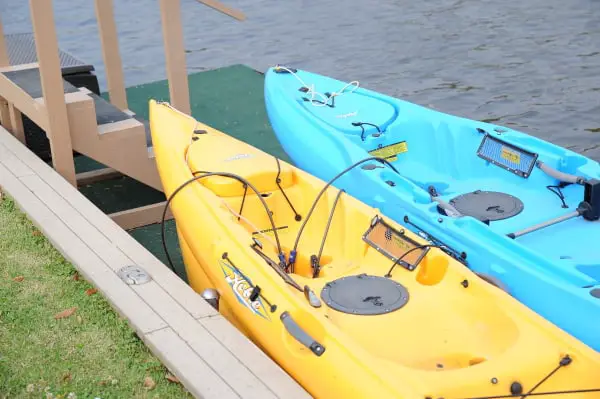
Kayaks are interesting water vessels. While small, a kayak is made up of many parts. Hatches, handles, hulls, cockpits, keels, and a whole host of other kayaking terms are used when talking about kayaks.
But why do kayaks have holes in them? Kayaks have scupper holes in them to help passively drain water from them. These holes keep the kayaker from having to actively bail water from their kayak and ultimately help keep the kayak from sinking.
A scupper hole can be found in the foot walls, in-tank wells, and even in the cockpit of the kayak. These holes can be used while on the water and while on land. They can even be plugged with small devices known as scupper plugs.
In the rest of this post, we’ll talk about when and why to take advantage of scupper holes and scupper plugs. We’ll also answer some questions people often ask in regards to these kayak holes.
Kayak Holes and Water
Built-in kayak holes are designed into the boat to help remove water. This keeps the deck from filling up with water and keeps the kayak from sinking.
The downside to these kayak holes is that they also have the potential to bring water into the kayak. This water isn’t a problem as it bails out by itself but it can lead to a wet ride. Scupper holes are especially known to bring water into the kayak when used on choppy water or by heavy people.
Choppy water will push water up into the kayak’s scupper holes. A lot of weight will force the kayak further into the water. A kayak that is forced further into the water will end up bringing in more water through the scupper holes.
Can Scupper Holes Be Plugged?
Scupper holes can be plugged with scupper plugs. These plugs may come with your kayak or you may have to buy universal scupper plugs for your kayak. The real question is whether or not you should plug your scupper holes.
Plugged scupper holes will not be able to drain water from the deck or any other area of your kayak. This means that water sitting inside of your cockpit will stay there until you bail it out. It also means that a large amount of water could sink your kayak.
Take a look at the video below to see how the scupper holes work to drain water from a kayak even when it is sitting on the water.
So why would somebody plug their kayak holes with scupper plugs? A plugged scupper hole will not allow water to get into your kayak. This means that you could end up with a dryer ride. Heavier people kayaking in calm water might especially benefit from plugged scupper holes.
What About Self Draining Scupper Plugs?
Want to plug your kayak holes without losing the benefit of scupper plugs? A self-draining scupper plug might be what you need.
A self-draining scupper plug is s scupper plug with a one-way valve fitted into it. This means it will allow water to flow through it from one direction but not the other.
Alternatives to Scupper Holes
There are a few alternatives to scupper holes. One option is to use a kayak spray skirt over the cockpit. A spray skirt is just a piece of material that fits over the cockpit so that water can’t splash into it. They are usually made of neoprene, nylon, or some combination of the two.
Another option is to use a bilge pump. A bilge pump can be used inside a sit-inside or a sit-on-top kayak so it’s a good option for people who own both types of kayaks. Buy one bilge pump and you can move it between kayaks when they’re in use.
Bilge pumps come in both manual and automatic forms. An automatic bilge pump will use a battery to power the pump and a manual one will be pumped by you.
What The Best Way To Drain A Kayak
In my opinion, you can’t go wrong with just leaving the scupper holes unplugged. Yes, you’ll get wet but this might actually be preferable in warm weather anyway. In cold weather, you can solve the problem of being cold by wearing the appropriate pants and shoes.
For people with sit-inside kayaks, you may want to go with a kayak skirt instead. The skirt will keep the water from getting in and it will help keep you a little warmer in cold weather. In this case, I’d advise you to consider bringing a manual bilge pump with you as well. This way, if some water does end up making it through your skirt, you can get it pumped out before re-adjusting your skirt.
